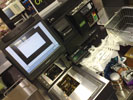

Saflec, in conjunction with the UK’s Thruvision has devised a security system for the detection of explosives.
At a time when the wholesale demolition of ATMs is not uncommon, the need for a device that can proactively detect explosives is high. In South
Africa, the source of the explosives used in ATM heists, mainly dynamite, is allegedly stolen from mining operations. It would appear that control over the issuing of dynamite to the blasting point leaves a lot to be desired due to the actual amount of explosive required for a particular blast and is extremely difficult to control from the issuing source. This in turn makes it easy for certain people to pick up unused sticks of dynamite and smuggle them out the mine.
The bottom line is that dynamite is allegedly disappearing from the mines and arriving in the hands of offenders who are using the dynamite to blow open ATMs. At present there is no way to detect such items other than by a pat down search. To attempt such a search on 2000 miners coming up from underground after a gruelling shift would not be very popular with the miners and the searchers may come in for a lot of verbal and physical abuse in trying to enforce such a search.
Saflec and Thruvison have an answer to this problem. The new scanner can scan people 'on the move' and search underneath clothing for any concealed objects. Early tests carried out clearly show items such as sticks of dynamite and packs of detonator caps carried on the person.
Part of a solution
This all sounds too good to be true and to a certain extent, it is. The scanner has to be incorporated into a security system to block every attempt at removing these dangerous items from the mine. For instance, we have found that the bags the miners take underground for various reasons such as food for their tea/lunch break are unsearched on arriving at the surface. These bags need to be X–rayed to ensure no contraband is carried out, therefore an X-ray unit is required at the search point.
Secondly, we need to control the environment in the form of temperature control and background emissions/reflections to get the best resolution out of the scanner and improve detection rates.
The third consideration is crowd control. It is important to guide the subjects through the system in an orderly fashion or the results obtained could be meaningless. If done in an orderly fashion, very little delay is experienced by the workers.
To satisfy the above we have chosen to go with a portable option. We use a 12 m container and kit it out to the above specifications. The container option has been chosen because this must be considered as a prototype operation as a container can in no way handle all the traffic on a mine.
Secondly, being a container it is extremely portable and can be shuttled around from point to point, or from shaft to shaft, or indeed from mine to mine. Once its reliability has been proven, more permanent structures capable of handling the complete mining staff can be planned.
More than explosives
Moreover, this system will also find copper wire, the theft of which is also pandemic in the mines. In fact, it will find anything that should not be on a person.
System components
We have used a turnstile entrance for crowd control as we feel if a door is used here there will be jostling and people moving into the area in numbers and this we do not want. We need a clear view of the back of the person for 6 seconds before the turnstyle operates again and lets the next person into the system. By this time the second scanner has had time to look at the frontal aspect of the approaching person. If either operator spots an anomaly, they would signal the system to open the search area door.
As the turnstile turns, so the X-ray machine advances the first bag for searching, so that as the subject leaves the turnstile his bag is there for collection. It is important that the subject and his belongings are not separated at any time other than in the search area and it is for this reason the X-ray belt moves in conjunction with the turnstile and does not run continuously. In the event of the operator detecting something he cannot identify in the baggage, this is again a prompt to press his search button.
Should a person pass through the area without cause for the system to intervene, the exit door opens and they are free to go The entire area is under CCTV observation and external monitors can observe the complete area, including the operators conducting the operation.
For more information contact Saflec Systems, +27 (0)11 477 4760, gordon.curr@saflec.com, www.safsys.co.za
| Tel: | +27 11 477 4760 |
| Email: | barend@saflecsystems.co.za |
| www: | www.saflecsystems.co.za |
| Articles: | More information and articles about Saflec Systems |
© Technews Publishing (Pty) Ltd. | All Rights Reserved.